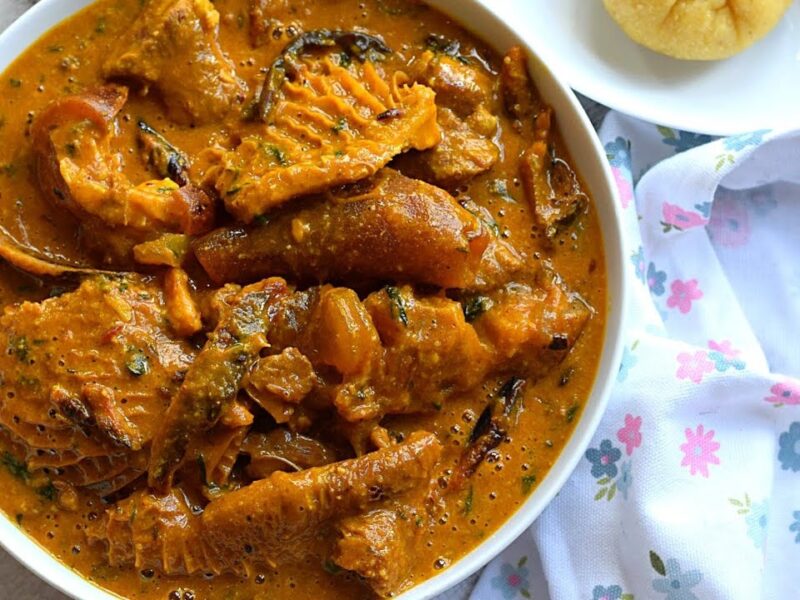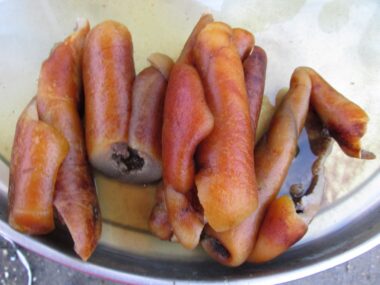Ogbono soup, also known as draw soup, is a beloved dish in Nigerian cuisine. Made from the seeds of the wild African mango (Irvingia gabonensis), this soup is renowned for its unique viscous texture, rich flavor, and nutritional benefits. Ogbono soup is a staple in many Nigerian households and is enjoyed across various regions with slight variations in preparation. This comprehensive guide explores the origins, ingredients, preparation methods, cultural significance, and health benefits of Ogbono soup.

Origins and Cultural Significance
Historical Background
Ogbono soup has deep roots in Nigerian culinary tradition. The wild African mango, also known as bush mango or dika nut, is indigenous to West Africa and has been used for centuries both as food and medicine. The seeds, commonly referred to as ogbono, are the star ingredient of this soup, valued for their thickening properties and rich, nutty flavor.
Regional Variations
While Ogbono soup is enjoyed nationwide, there are regional variations that add a unique touch to the dish:
- Eastern Nigeria: In the Igbo-speaking regions, Ogbono soup is often cooked with a combination of meats, fish, and leafy vegetables like bitter leaf or ugu (fluted pumpkin leaves).
- Western Nigeria: Among the Yoruba people, Ogbono soup may include stockfish and assorted meats, with a preference for a thicker consistency.
- Southern Nigeria: In the Niger Delta, Ogbono soup might be spiced with additional seafood such as periwinkles and prawns, reflecting the region’s coastal culture.
Cultural Celebrations
Ogbono soup is not just a daily meal but also a dish for special occasions. It is commonly served during family gatherings, festivals, and traditional ceremonies, symbolizing hospitality and the rich culinary heritage of Nigeria.
Ingredients and Their Nutritional Benefits
Core Ingredients
- Ogbono Seeds: The key ingredient, ground ogbono seeds, provides the characteristic thick and slimy texture. They are rich in healthy fats, proteins, and dietary fiber.
- Palm Oil: This adds a vibrant color and rich flavor to the soup. Palm oil is high in vitamins A and E, which are essential for vision and skin health.
- Assorted Meats and Fish: Common choices include beef, goat meat, stockfish, dried fish, and tripe. These add depth to the flavor and provide protein and essential nutrients.
- Vegetables: Leafy greens like ugu (fluted pumpkin leaves), bitter leaf, or spinach are added for freshness and nutritional value, supplying vitamins, minerals, and antioxidants.
- Seasonings: Traditional seasonings include crayfish, seasoning cubes, salt, and pepper, which enhance the flavor profile of the soup.
Optional Ingredients
- Prawns and Periwinkles: Often added in coastal regions for a seafood twist.
- Okra: Sometimes included to enhance the slimy texture and add extra fiber.
Preparation Methods
Traditional Preparation
- Preparing the Ingredients:
- Soak the stockfish and dried fish in water to soften them.
- Clean and cut the meats into bite-sized pieces.
- Grind the ogbono seeds into a fine powder.
- Chop the vegetables and set aside.
- Cooking the Meats:
- In a large pot, add the assorted meats and season with salt, seasoning cubes, and onions.
- Add water and cook until the meats are tender.
- Preparing the Ogbono Paste:
- In a separate bowl, mix the ground ogbono seeds with palm oil to form a smooth paste.
- Combining Ingredients:
- Add the soaked stockfish, dried fish, and crayfish to the pot with the meats.
- Stir in the ogbono paste, ensuring it dissolves completely into the broth.
- Allow the soup to cook, stirring occasionally to prevent sticking, until it thickens and achieves a slimy consistency.
- Adding Vegetables:
- Add the chopped vegetables and let the soup simmer for a few more minutes until the vegetables are tender but still vibrant.
- Final Seasoning:
- Adjust seasoning with salt and pepper to taste.
- If using prawns or periwinkles, add them at this stage and cook until they are done.
Modern Variations
- Pressure Cooker Method: To save time, the meats can be cooked in a pressure cooker, which reduces the cooking time significantly.
- Healthier Alternatives: For a healthier version, use less palm oil or substitute with vegetable oil. You can also incorporate more vegetables and leaner cuts of meat.
- Vegetarian Ogbono Soup: For a vegetarian version, omit the meats and fish, and use mushrooms or tofu as protein substitutes. Increase the variety of vegetables for a wholesome meal.
Serving Suggestions
Ogbono soup is traditionally served with a variety of Nigerian staples, including:
- Pounded Yam: This is the most popular accompaniment, providing a smooth and stretchy texture that pairs perfectly with the slimy soup.
- Fufu: Made from fermented cassava, fufu is another common pairing that complements the rich flavors of the soup.
- Eba (Garri): Made from cassava flour, eba is a convenient and easy-to-prepare side for Ogbono soup.
- Amala: Made from yam flour, amala is favored in Western Nigeria and offers a distinct flavor that goes well with Ogbono soup.
Health Benefits of Ogbono Soup
Nutrient-Rich Ingredients
- Ogbono Seeds: High in healthy fats, protein, and fiber, ogbono seeds contribute to heart health, improved digestion, and satiety.
- Palm Oil: While high in saturated fat, palm oil in moderation provides essential vitamins A and E, supporting immune function and skin health.
- Leafy Vegetables: Vegetables like ugu and bitter leaf are rich in vitamins, minerals, and antioxidants, promoting overall health and wellbeing.
Balanced Meal
Ogbono soup, when paired with a starchy side like pounded yam or fufu, offers a balanced meal with carbohydrates, proteins, fats, and a variety of micronutrients.
Weight Management
The high fiber content in ogbono seeds and vegetables aids in digestion and can help with weight management by promoting a feeling of fullness and reducing overall calorie intake.
Blood Sugar Control
The complex carbohydrates in pounded yam, fufu, and other sides release glucose slowly, which can help maintain stable blood sugar levels, making Ogbono soup a suitable option for individuals managing diabetes.
Tips for Making the Perfect Ogbono Soup
- Quality Ingredients: Use fresh and high-quality ingredients, especially the ogbono seeds, to ensure the best flavor and consistency.
- Consistent Stirring: Stir the soup frequently to prevent the ogbono paste from clumping or sticking to the pot.
- Moderate Heat: Cook on moderate heat to allow the flavors to meld and the soup to thicken properly without burning.
- Season Gradually: Add seasonings gradually and taste frequently to avoid over-seasoning.
- Experiment with Additions: Feel free to experiment with different proteins and vegetables to suit your taste preferences and nutritional needs.
Conclusion
Ogbono soup is a quintessential Nigerian dish that embodies the rich culinary traditions and diversity of the country. Its unique texture, flavorful ingredients, and nutritional benefits make it a beloved meal across various regions. Whether enjoyed with pounded yam, fufu, or any other staple, Ogbono soup offers a satisfying and wholesome dining experience. By following traditional preparation methods and incorporating modern variations, you can enjoy this delicious soup while reaping its numerous health benefits. Embrace the flavors of Nigeria and add Ogbono soup to your culinary repertoire for a taste of authentic Nigerian cuisine.










